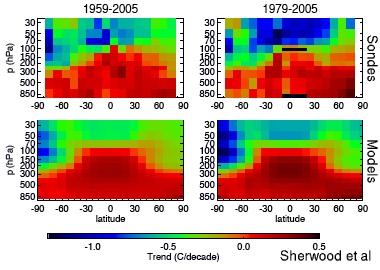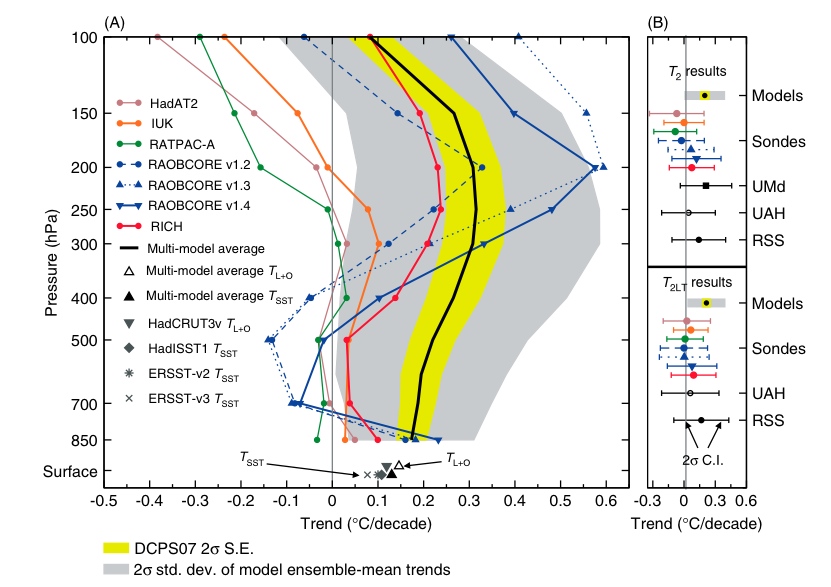Troposphere Not Warming
This is a common denialist/skeptic meme. The reality is that while there are significant complexities in the tropospheric measurements and models, homogenized analysis indicates that the troposphere is doing what is expected of it in accord with the various models and general expectations.
Satellite measurements have had their problems and continued observation and modeling aids in correcting for aberrations, errors, and biases. Reasonably dealing with biases in data, and aberrations, are important to assessing the reasonability of a particular data set. This of course needs to be considered with other data sets and models. This is an inter-dynamic process, and continues to improve as more and more scientists examine the models and observations.
IPCC AR4 WG1 (Chap. 9 page 674, col. 1, para. 2)
“Greenhouse gas forcing is expected to produce warming in the troposphere, cooling in the stratosphere, and, for transient simulations, somewhat more warming near the surface in the NH (Northern Hemisphere) due to its larger land fraction, which has a shorter surface response time to the warming than do ocean regions.”
Skeptics/Denialists
Essentially the skeptics/denialists are drawing conclusions before the empirical analysis justifies the conclusions they are drawing. One might characterize this as unwise. Others might say it is unscientific. Still others might say it is fraudulent.
Download Lord Moncktons Paper (PDF) Greenhouse Warming? What Greenhouse Warming?
Back in Reality
A general analysis by Gavin Schmidt (NASA/GISS) illustrates that the structural uncertainty in radiosonde data is large. The models are improving but there is already a signal developing slightly above the noise that is somewhat distinguishable. The observations and the models seem to be coming into focus with relative accuracy, but structural uncertainty remains high. One can not yet draw strong conclusions from the comparison between these models and observations.

There is still the challenge of separating the signal from the noise but the picture is becoming clearer. At this point, one can see that in both Sonde observations there is potential that the ‘Global Warming Signature’ will become further verified. The image the denialists use to disprove this is of course only a cherry pick and facts out of context thus making their point null and void.
December, 2007
The Tropospheric Confusion in the Denialosphere
While multiple origins through the blogosphere play a part, the focus on the question originates with RealClimate.org when they considered the out of context arguments of certain individuals who have established a reputation of making up their own interpretations of the data at hand without relevant context. These included some familiar names: Douglass, Pearson and Singer, now joined by Christy.
The assessment at that time indicated that:
“…this isn’t a demonstration that the tropical trends in the model simulations or the data are perfectly matched – there remain multiple issues with moist convection parameterisations, the Madden-Julian oscillation, ENSO, the ‘double ITCZ’ problem, biases, drifts etc. Nor does it show that RAOBCORE v1.4 is necessarily better than v1.2. But it is a demonstration that there is no clear model-data discrepancy in tropical tropospheric trends once you take the systematic uncertainties in data and models seriously. Funnily enough, this is exactly the conclusion reached by a much better paper by P. Thorne and colleagues. Douglass et al’s claim to the contrary is simply unsupportable.” – Real Climate
2008, May
Tropical Troposphere Again
“In the global mean, there isn’t much of an issue for the mid-troposphere – the models and data track each other when you expect they would (the long term trends or after volcanoes, and don’t where you expect them not to, such as during La Niña/El Niño events which occur at different times in models and observations). Similarly the lower stratospheric trends and variability is reasonably matched except for the post-Pinatubo period where the sondes cool uniformly more than the models – possibly due to underestimation of the stratospheric ozone trend. However, the big discrepancies are in the tropics.”
– Gavin Schmidt
The authors of the various relevant papers find that:
“Each of the different, and independent, methodologies ends up finding pretty much the same thing. If you do a better job on the homogenisation, you end up with answers closer to the expected moist adiabatic amplification of the trend with height. It bears stating again that the expected amplification has nothing to do with the greenhouse effect – it is just a function of the surface warming. Note also that this result was nowhere built in to the analyses and so to find that the most consistent readings produce just that is a validation of all the approaches.”
– Gavin Schmidt
Assessment
“To conclude, the structural uncertainty in the radiosonde data is large, and while these attempts to improve the homogenisation are a step in the right direction, the degree of adjustment is a concern. The bottom line is that the observations may well be closer to the model data than preliminary analyses suggested but that the structural uncertainty remains high. Coming to dramatic conclusions based on any of this remains unwise.”
– Gavin Schmidt
Peter Thorne concludes that:
“The new analysis adds to the growing body of evidence suggesting that these discrepancies are most likely the result of inaccuracies in the observed temperature record rather than fundamental model errors.”
2008, October
Tropical Troposphere Again, Again
The new 17-author paper (accessible pdf) (lead by Ben Santer), does a much better job of comparing the various trends in atmospheric datasets with the models and is very careful to take account of systematic uncertainties in all aspects of that comparison (unlike Douglass et al). The bottom line is that while there is remaining uncertainty in the tropical trends over the last 30 years, there is no clear discrepancy between what the models expect and the observations. There is a fact sheet available which explains the result in relatively simple terms.
– Gavin Schmidt
Assessment
Taking a slightly larger view, I think this example shows quite effectively how blogs can play a constructive role in moving science forward (something that we discussed a while ago). Given the egregiousness of the error in this particular paper (which was obvious to many people at the time), having the initial blog posting up very quickly alerted the community to the problems even if it wasn’t a comprehensive analysis. The time in-between the original paper coming out and this new analysis was almost 10 months. The resulting paper is of course much better than any blog post could have been and in fact moves significantly beyond a simple rebuttal. This clearly demonstrates that there is no conflict between the peer-review process and the blogosphere. A proper paper definitely takes more time and gives generally a better result than a blog post, but the latter can get the essential points out very quickly and can save other people from wasting their time.
– Gavin Schmidt
Summary
For Singer, Christy, Pearson and Douglass, it is easy to confuse the public when one uses the baffling with BS technique combined with bludgeoning with irrelevance. The skeptic/denialist side knows that all they have to do is ‘sound’ scientific. It is not necessary to ‘be’ scientific and consider all the relevant science available.
Whether, naive, ignorant or fraudulent, it matters not. It simply does not add to the contextually relevant understanding, especially when weighed against all the relevant evidence, models and observed indicators combined with the well understood physics.
In short, the idea that the troposphere is not cooperating with the models is based on narrow-minded (cherry-picked) views presented by the same old skeptics that have no ‘real’ relevance in the reasonable scientific debate.
Unfortunately they (denialists/skeptics), and others like them remain myopic and continue to confuse the issues.
Links

